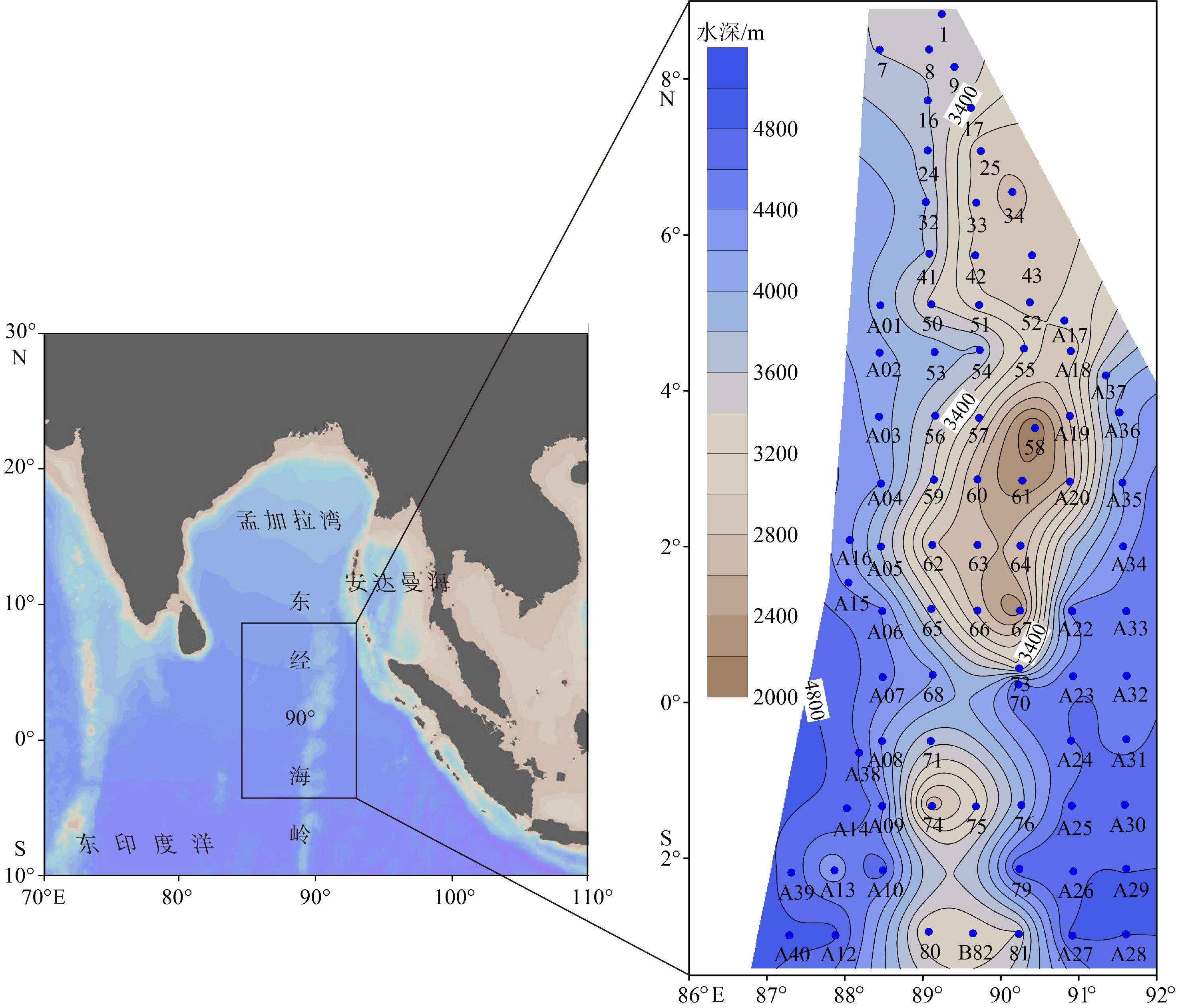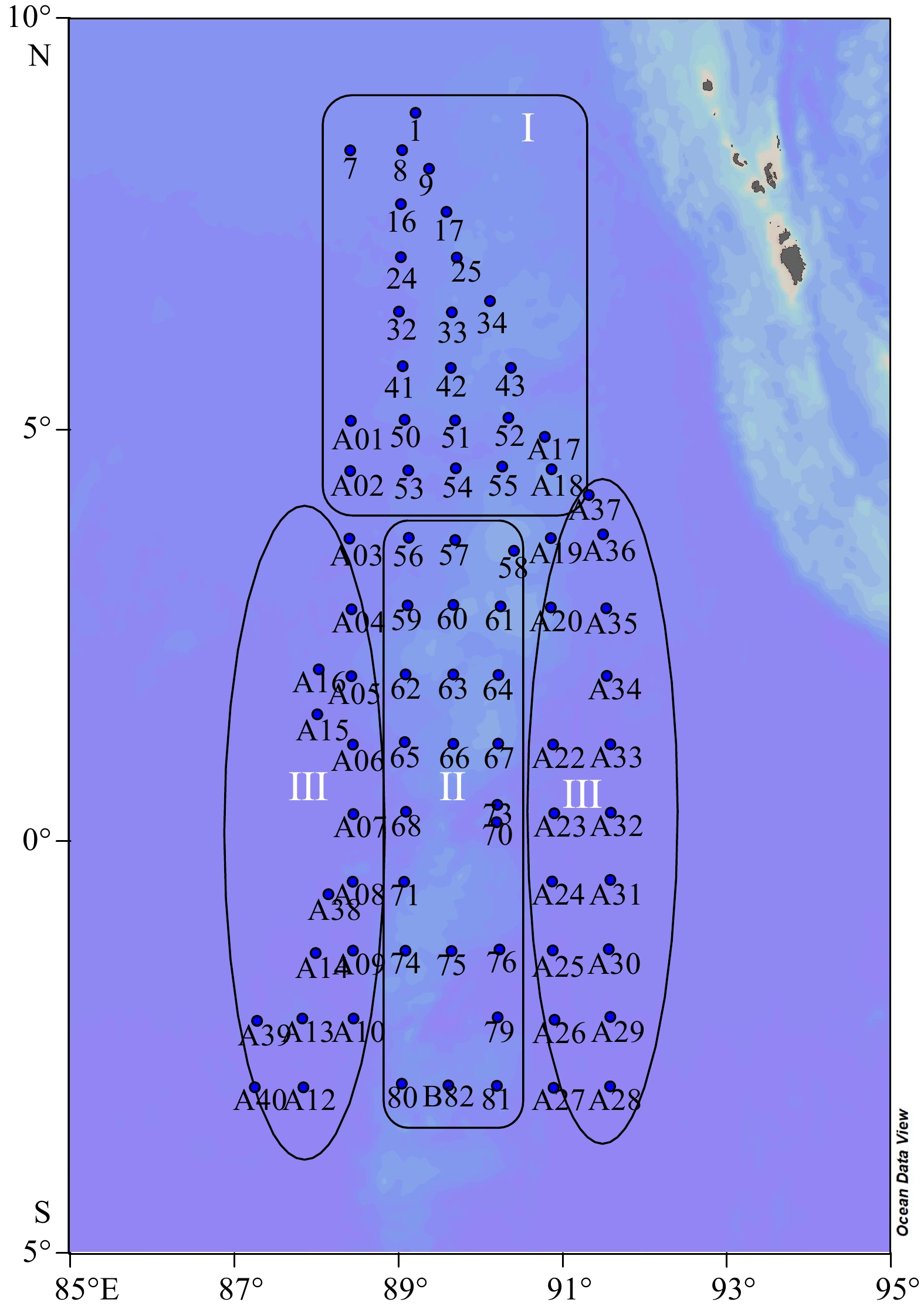Distribution and influencing factors of planktonic foraminifera in surface sediments of the Ninetyeast Ridge in Indian Ocean
-
摘要: 对东印度洋90°海岭附近海域82个表层沉积物样品中的浮游有孔虫进行鉴定统计分析,揭示了研究区表层沉积物中浮游有孔虫区域分布特征,并对其影响因素进行了初步探讨。研究表明,东印度洋90°海岭附近海域表层沉积物中浮游有孔虫呈现典型的热带-亚热带组合特征,共鉴定出浮游有孔虫30种。运用聚类分析,得到3个浮游有孔虫组合:组合类群I主要分布在5°~10°N的孟加拉湾南部开阔海域,主要种属包括Globigerinoides sacculifer,Globigerinoides ruber,Neogloboquadrina dutertrei,体现了生产力及海水盐度对有孔虫组合的影响;组合类群II主要在5°N至5°S,沿东经90°海岭分布。主要种属包括Globigerinoides ruber,Globorotalia menardii,Neogloboquadrina dutertrei,体现了水深及生产力对有孔虫组合的影响;组合类群III对称分布在组合类群II两侧水深较深的海域,主要种属包括Globorotalia tumida,Globorotalia menardi,Pulleniatina obliquiloculata,体现了水深对有孔虫组合特征的影响。根据有孔虫组合类群分布特征,推断水深、盐度及生产力是影响本海域浮游有孔虫分布的最主要因素。Abstract: Eighty-two surface sediment samples were collected from the Ninetyeast Ridge of the eastern Indian Ocean, from which planktonic foraminifera community fossils were identified and statistically analyzed. The regional distribution characteristics of planktonic foraminifera in surface sediments were revealed, and the influencing factors discussed. Results show that the planktonic foraminifera displayed typical tropical-subtropical attributes, and 30 species of planktonic foraminifera were identified. The planktonic foraminifera were classified into groups (assemblages) in cluster analysis. Group I included mainly Globigerinoides sacculifer, Globigerinoides ruber, and Neogloboquadrina dutertrei, distributed mostly in the open sea area in the south of the Bay of Bengal from 5°N to 10°N, and affected by productivity and salinity of seawater. Group II included Globigerinoides ruber, Globorotalia menardii, and Neogloboquadrina dutertrei, occupied mainly between 5°N and 5°S along the Ninetyeast Ridge, and related to the depth and productivity. Group III contained mainly Globorotalia tumida, Globorotalia menardi, and Pulleniatina obliquiloculata, distributed symmetrically in deep water areas on both sides of Group 2, and were closely depth dependent. Therefore, the distribution patterns of planktonic foraminifer assemblages are closely affected by water depth, salinity, and productivity of planktonic foraminifera in the sea area.
-
东经90°海岭是位于赤道东印度洋海域的一条重要海岭,呈线性沿90°经线展布。东印度洋三面临陆,海陆间的热力差导致明显的季风活动。夏季风盛行时,海洋上空蒸发的大量水汽随西南季风吹至北侧大陆,形成降水后经河流输入孟加拉湾,致使表层海水盐度降低,且离陆地越近,海水盐度越低[1]。受季节影响明显,8月夏季风盛行,丰富的淡水输入使盐度相比2月下降近4‰[2],但等值线总体呈西北—东南走向[3](图1a-b)。相对于盐度存在明显的梯度变化,研究区表层海水年平均温度较高且变化不显著,平均26~29℃。大洋生产力的变化影响到CO2浓度、海水碳酸盐溶解,对了解气候演变有重要意义,生活在大洋表层的浮游有孔虫丰度受表层海水生产力的影响,因此,浮游有孔虫丰度能够反映表层海水生产力变化[4]。研究区无明显的上升流活动[5],生产力的高低主要受季风降水带来的陆源物质的影响。来自恒河以及雅鲁藏布江的陆源物质是东北印度洋营养物的主要来源[6]。在陆源输入的营养盐中,有孔虫生长主要依靠磷酸盐[2](图1c-d)。强烈的季风气候及复杂的地形加剧了东印度洋环境变化。而东经90°海岭作为东印度洋一个重要的地质单元,探讨现代沉积中有孔虫的空间分布规律及其与海洋环境之间的关系,不仅对研究沉积物运输有重要意义,而且可为还原古海洋环境演化、预测未来环境变化提供可靠证据。
![]() 图 1 研究区表层海水盐度及磷酸盐含量分布图a: 2月表层海水盐度,b: 8月表层海水盐度,c: 2月磷酸盐含量,d: 8月磷酸盐含量。数据来源:NOAA;利用 Ocean Data View 软件绘制。Figure 1. The distribution map of salinity and phosphate in the study areaa: average salinity of surface seawater in February, b: average salinity of seawater in August, c: phosphate content in February, d: phosphate content in August.
图 1 研究区表层海水盐度及磷酸盐含量分布图a: 2月表层海水盐度,b: 8月表层海水盐度,c: 2月磷酸盐含量,d: 8月磷酸盐含量。数据来源:NOAA;利用 Ocean Data View 软件绘制。Figure 1. The distribution map of salinity and phosphate in the study areaa: average salinity of surface seawater in February, b: average salinity of seawater in August, c: phosphate content in February, d: phosphate content in August.浮游有孔虫作为一种生活在海洋里的单细胞原生动物,具有数量多、种类多、易于识别、地理分布广、对环境变化反应敏感等特点,生物学特征显著,其群落数量、属种组合和保存状况受到水深、温度、盐度等多方面环境因子影响[7-11]。Thunell[12]、 Fairbanks[13]等认为表层沉积物中的浮游有孔虫分布和组合变化受特定的温度、盐度及表层水团的影响。郑执中、汪品先等较早地探讨了影响南海有孔虫分布的水深、温度、盐度等环境因素[14-16]。孙荣涛等借助因子分析将冲绳海槽北部表层沉积中的浮游有孔虫划分为3个组合,认为研究区有孔虫受海流、水团及水深等多因素影响[17]。另外,钙质浮游有孔虫是大洋生源碳酸盐的主要生产者,水深是影响碳酸盐溶解作用的重要因素。通过研究浮游有孔虫的群落组成,结合底栖有孔虫丰度、相对百分含量及碎壳率、溶解指数等指标,不仅可以确定现代大洋碳酸盐溶跃面深度及碳酸盐补偿深度[18-20],而且对追踪历史时期溶跃面变迁也有重要意义[19-21]。
关于印度洋海域浮游有孔虫指示环境的研究已有了一定的基础。丁旋等[22-23]、魏华玲等[4,24]及刘勇勤[25]对东印度洋海域浮游有孔虫生态学特征及丰度变化进行了研究,结合沉积记录、同位素和碳酸钙地层等,探讨其与季风活动、上升流之间的关系。Symphonia T等通过研究东印度洋表层沉积物中的浮游有孔虫,认为其丰度及分布特征与水深、粒度盐度之间的相关性比其他环境指标更好[26]。有孔虫组合特征对环境的指示意义往往比单一属种更为可靠[27-28],利用数值分析方法对有孔虫群落进行定量分析可以很好地反映上层海水性质,因子分析、聚类分析等方法被逐渐引入有孔虫种群研究中。张玲芝等对安达曼海有孔虫群落进行Q型因子分析,将研究区全新世以来的海洋环境划分为3个明显的阶段,认为安达曼海浮游有孔虫所反映的环境变化与陆地夏季风记录有很好的相关性,热带边缘海区的有孔虫群落组合可以很好地响应区域海洋环境变化[11]。张洁对南印度洋表层沉积的有孔虫进行聚类分析,结合区域背景将研究区划分为8个群组,还原上层海水信息[29]。AnbuselvanN等借助聚类分析、主成分分析及相关分析,揭示了印度洋孟加拉湾22种浮游有孔虫的分布格局,通过对优势种进行聚类分析划分了两个浮游有孔虫组合,讨论了孟加拉湾西南部浮游有孔虫组合与水深、温度、盐度之间的关系[30]。
东印度洋海域沉积物中有孔虫研究程度相比中国边缘海和西太平洋海域仍比较薄弱,本文利用东经90°海岭附近海域表层沉积物中浮游有孔虫鉴定分析统计结果,并结合聚类分析方法,探讨研究区浮游有孔虫区域分布特征及其主要影响因素,结合研究区的海洋环境,以期探讨东印度洋表层沉积物中浮游有孔虫分布特征与现代海洋环境的关系,为东印度洋浮游有孔虫现代沉积过程提供重要认识。
1. 材料及方法
本文研究材料为国家海洋局南海调查技术中心2019年和2020年11—12月在印度洋东经90°海岭附近海域利用箱式取样器获取的82个表层沉积物样品,取样水深范围为2013~4866 m,具体站位及水深见图2。微体古生物有孔虫鉴定分析工作在自然资源部第一海洋研究所海洋沉积与环境地质实验室完成。样品的前处理严格按照有孔虫标准处理流程,沉积物样品于60℃烘箱中恒温烘干后,称取10 g左右干样,放入烧杯中加自来水浸泡至完全分散,用孔径为0.063 mm的标准铜筛冲洗,将筛洗后的样品烘干进行鉴定分析,有孔虫镜下鉴定>150 μm的组分,每个样品统计个数不少于300颗。本次研究除了定量统计浮游有孔虫的种属及个数外,同时统计了底栖有孔虫个数及浮游有孔虫碎壳数。有孔虫鉴定标准与计算方法主要参考James P Kennett 和 Srinivasan M S 等[31]相关文献。碎壳率计算采用Le 和Schackleton等[32]的公式:碎壳率=(碎壳数/8)/(碎壳数/8+整壳数)×100。
2. 结果和讨论
2.1 有孔虫丰度及分异度
研究区82个表层沉积物样品中都见有孔虫,浮游有孔虫丰度(每克干样中浮游有孔虫的个体数)变化较大,最高丰度27647枚/g,最低为7枚/g,平均5626枚/g,其变化明显受水深影响。浮游有孔虫丰度高值位于海岭上相对浅水区域,最高值出现在61站位,丰度值高达27647枚/g干样,最低值出现在研究区西南部的A12站位,仅为7枚/g干样。每克干样中底栖有孔虫的个体数为0~912枚,平均71枚/g,底栖有孔虫丰度高值出现在研究区西南部的深水区域(图3)。表层样品中有孔虫群落组成以浮游有孔虫为主,占有孔虫全群百分比为20%~100%,平均85%,底栖有孔虫含量不高。浮游有孔虫个体发育较好,呈现出典型的热带亚热带地区浮游有孔虫组合面貌。
浮游有孔虫群落中平均百分含量在5%以上的优势种有Globorotalia menardii, Globigerinoides ruber, Globigerinoides sacculifer, Neogloboquadrina dutertrei, Globorotalia tumida, Pulleniatina obliquiloculata, Globigerinita glutinata;平均含量在3%以上的常见种有Globigerina bulloides, Globigerinella calida, Globigerinella siphonifera, Globoquadrina conglomerata, Neogloboquadrina pachyderma(R);其他属种还有Globigerinoides conglobatus, Globorotaloides hexagona, Sphaeroidinella dehiscens, Globigerinoides tenellus, Orbulina universa, Globigerina falconensis, Candeina nitida, Globorotalia scitula等。
研究区浮游有孔虫的分异度如图4所示。简单分异度最小值为5,最大值为22,复合分异度值为0.97~2.63,从图中可以看出,简单分异度和复合分异度的低值区大致分布于研究区南部两侧的深水区域,而高值区主要集中在海岭中部的相对浅水区。
2.2 浮游有孔虫壳体溶解率
浮游有孔虫是开放大洋上层水体生源碳酸盐的主要生产者,水深是影响浮游有孔虫钙质壳体溶解的重要影响因素[19],不同有孔虫也呈现出不同的抗溶性能,于是在大洋出现浮游有孔虫的“选择性溶解”[25]。
82个表层样品中浮游有孔虫的碎壳率为2.4%~91.9%,平均37.8%,超过三分之一的沉积物样品中有孔虫碎壳率在50%以上,显示出强烈的溶解现象。从浮游有孔虫碎壳率分布图(图5)中可以看出,碎壳率明显受水深因素控制,海岭上浅水区域碎壳率较低,而研究区两侧的深水区域碎壳率极高,最高值91.97%出现在水深4747 m的A40站位。
2.3 浮游有孔虫优势种分布特征
对鉴定数据进行统计分析,挑选了7个平均百分含量大于5%的属种数据平面成图,按平均含量由高到低依次为Globorotalia menardii (13.64%), Globigerinoides ruber (13.54%), Globigerinoides sacculifer (12.15%), Neogloboquadrina dutertrei (10.33%), Globorotalia tumida (10.20%), Pulleniatina obliquiloculata (9.01%), Globigerinita glutinata (5.21%),这7个优势种占浮游有孔虫全群的百分含量最小值、最大值和平均值见表1,平均百分含量大于5%的7个优势种的百分含量平面分布图见图6和图7。
表 1 研究区表层样浮游有孔虫优势种百分含量统计Table 1. Statistical table of relative abundance of dominant planktonic foraminifera in surface sediments in the study area属种名 最大值/% 最小值/% 平均值/% Globorotalia menardii 42.90 2.41 13.64 Globigerinoides ruber 31.73 0.00 13.54 Globigerinoides sacculifer 26.16 0.00 12.15 Neogloboquadrina dutertrei 19.28 0.83 10.33 Globorotalia tumida 65.56 0.00 10.20 Pulleniatina obliquiloculata 24.33 0.00 9.01 Globigerinita glutinata 16.95 0.00 5.21 图6是浮游有孔虫Globigerinoides ruber、 Globigerinoides sacculifer、 Globigerinita glutinata在研究区表层沉积物中的平面分布图。这3个种都属于易溶种,从图上也可以看出,这3个种在研究区的分布特征比较类似,高值区位于海岭相对浅水区,而海岭两侧的深水区则含量极低。
Globigerinoides ruber是大洋中分布最广、含量最高的暖水种之一,是最常见的热带-亚热带浮游有孔虫[7],该种广温广盐,生活在温跃层上部的混合层水体里[8],最适宜温度为27 ℃左右,为浅层易溶种。其在研究区表层沉积物浮游有孔虫群落中,含量变化范围为0~31.73%,平均为13.54%,含量最高值出现在研究区中部的海岭上。
Globigerinoides sacculifer为典型热带浅水种,为易溶的浅层水种,适宜温度、盐度变化小的水体,不适应大范围的季节性盐度变化,最高含量分布于20°N到20°S之间[7]。占研究区浮游有孔虫全群的平均百分含量为12.15%,最大值为26.16%,出现在研究区中部的57号站位,有少量几个站位没有发现该种。
Globigerinita glutinata为热带-亚热带种,纬度分布相对广泛,主要分布于高营养的上升流水体中[8]。在西北太平洋被看作主要的黑潮指示种之一[33]。在研究区表层沉积物浮游有孔虫群落中,百分含量为0~16.95%,平均为5.21%,其含量分布规律与Globigerinoides ruber的分布规律基本类似。
图7是研究区表层沉积物中浮游有孔虫Globorotalia menardii、Globorotalia tumida、Neoglobo-quadrina dutertrei、Pulleniatina obliquiloculata的平面分布图。这4个种为研究区浮游有孔虫群落中的抗溶种,从图上可以看出,这4个属种在研究区的分布特征比较类似,低值区位于海岭上相对浅水区,而在海岭两侧的深水区则为高值区。
Globorotalia menardii属热带-亚热带种,为不易溶的深层水种,偏好表层海水温度高、盐度正常的水体,在生产力较高的上升流地区丰度高[7-8]。在研究区表层沉积物浮游有孔虫群落中的百分含量为2.41%~42.90%,平均值为13.64%,相对高值区位于研究区海岭两侧深水区,低值区位于中部浅水区。
Globorotalia tumida在研究区表层沉积物浮游有孔虫群落中的百分含量为0~65.56%,平均值为10.20%,高含量区位于研究区南部两侧深水区,研究区中部和北部区域为低值区。
Neogloboquadrina dutertrei属热带-亚热带种,主要分布于强洋流体系、大陆边缘以及上升流区,叶绿素含量最高的地区丰度较高,为中层水种,大洋中央水团含量较低[7-8]。在研究区表层沉积物浮游有孔虫群落中的百分含量为0.83%~19.28%,平均值为10.33%,高值区位于研究区北部和海岭两侧深水区,低值区位于中部和南部。
Pulleniatina obliquiloculata属热带浅水种,主要分布在混合层之下[7,34],与丰富的浮游植物和高生产力相关,在冲绳海槽被视为黑潮标志指示种之一[9],指示高温高盐的水体环境。在研究区表层沉积物浮游有孔虫群落中的百分含量为0~24.33%,平均值为9.01%,其分布特征与Neogloboquadrina dutertrei的分布规律基本相同。
2.4 有孔虫组合特征与沉积环境
为更加直观地描述研究区有孔虫种属分布特征,进一步研究浮游有孔虫与环境之间的关系,我们利用国际上广泛适用于生物群落结构分析的SPSS 23 软件,对上述样品中18个主要浮游有孔虫属种(相对百分含量至少在3个样品中含量大于2%的属种)进行聚类分析。对生成的系谱图划分出3个属种组合(图8-9),并统计了各组合的主要属种含量(表2),结合研究区海洋环境特征,对其相关性进行探讨。
表 2 各组浮游有孔虫主要种属含量分布Table 2. Content distribution of main species of planktonic foraminifera in each group种属 组合I 组合II 组合III Globigerinoides ruber 16.30% 19.68% 3.10% Globigerinoides sacculifer 17.31% 15.54% 4.80% Globorotalia menardii 10.04% 10.23% 21.15% Neogloboquadrina dutertrei 13.32% 10.22% 8.87% Pulleniatina obliquiloculata 9.12% 7.21% 11.01% Globoquadrina conglomerata 6.15% 6.17% 2.23% Globigerina bulloides 4.79% 3.85% 1.49% Globigerinita glutinata 4.68% 6.77% 2.44% Globorotalia tumida 1.24% 1.26% 27.04% 组合类群I主要分布在5°~10°N的孟加拉湾南部开阔海域,主要种属为Globigerinoides sacculifer(17.31%),Globigerinoides ruber(16.3%)以及Neogloboquadrina dutertrei(13.32%)。此组合在南海被认为受来自西太平洋的热带水团控制,指示高温高盐的水体特征[35]。其中,Pulleniatina obliquiloculata在冲绳海槽被视为黑潮标志指示种之一[9],指示高温高盐的水体环境,Neogloboquadrina dutertrei被认为是高生产力的指示种[9],也被看作是黑潮的指示种之一[10],Jones通过研究赤道大西洋底流及其上的水团认为,这两种浮游有孔虫标志着约50~100 m的高盐度底流[25]。Globorotalia menardii偏好表层海水温度高的水体,这指示高温、高盐、高生产力的水体特征。调查区海水温度较高且季节性温度差异不显著,平均水温26~29°C[36]。但盐度存在相对明显的梯度变化(图1a-b),等值线总体呈西北—东南走向[3]。研究表明盐度是影响本研究区有孔虫分布及组合差异的主要原因。浮游有孔虫的丰度严格受表层生产力的影响,由于各种浮游有孔虫要求的海水肥力不同,所以可以用特定有孔虫的含量表征生产力[25],研究区现代上升流不显著,因此高生产力可能是季风降水增强地表径流后使表层水体更富营养的结果[37]。来自恒河以及雅鲁藏布江的陆源物质是东北印度洋营养物的主要来源[6]。根据磷酸盐占主要营养盐百分比(图1c-d)可以看出,大量陆源磷酸盐输入使研究区生产力水平提高,并呈现明显梯度变化[2]。因此,组合类群I主要受生产力及海水盐度的共同影响。
组合类群II主要在5°N至5°S范围,沿东经90°海岭分布在水深较浅海区。主要种属是Globigerinoides ruber (19.68%),Globigerinoides sacculifer(15.54%)及Globorotalia menardii (10.23%)。丰度及分异度均属研究区内最高。此区域广温广盐的种属Globigerinoides ruber占比最大,且属研究区最高值,Globigerinoides sacculifer丰度相对下降,二者虽都属于暖水浅水种, 但生活的温盐环境略有不同。Globigerinoides sacculifer倾向于温度高 1℃、盐度高 0.3‰左右的海水环境[7]。同时,热带高盐属种Pulleniatina obliquiloculata (7.21%)及Neogloboquadrina dutertrei (10.22%)丰度下降,这可能指示盐度下降,但由于研究区北部有河流稀释作用,所以离陆越远,海水盐度应越高[1],因此盐度不是影响该区属种变化的主要原因。而Globigerinoides ruber是一种生活在海水上部的“浅层水种”,是现生浮游有孔虫中生活范围最小的一种[38]。在浅水环境,许多其他浮游有孔虫生活环境受到制约,Globigerinoides ruber的相对丰度就会增高。组合II主要分布在海岭之上,相较于组合类群I(水深3000~3500 m),组合II水深(2500~3500 m)更浅,因此Globigerinoides ruber的含量上升,指示水深对浮游有孔虫分布的影响。另外,相较于区域I,区域II内反映高生产力的Neogloboquadrina dutertrei及上升流指示种Globigerina bulloides含量均有所下降,指示生产力水平的相对降低。这与图1d所指示的磷酸盐含量对应较好。由于生产力的高低主要受季风降水带来的陆源有机质的影响,因此生产力的下降,可能指示陆源营养物质输入减少。因此,组合类群II主要受水深及生产力的影响。
组合类群III主要分布在5°N至5°S范围,对称分布在组合类群II的两侧。主要种属为Globorotalia tumida (27.04%),Globorotalia menardii (21.15%)以及Pulleniatina obliquiloculata (11.01%)。区域III与区域II 的差异主要体现在水深上,区域III分布在海岭两侧深水区域,水深3500~5000 m,区域II主要分布在东经90°海岭之上,水深2500~3500 m。该组合内Globigerinoides ruber以及Globigerinoides sacculifer等易溶种属急剧减少,个别站位绝对丰度为0,其主要种属Globorotalia tumida,Globorotalia menardii以及Pulleniatina obliquiloculata均为抗溶种。因此,影响组合类群III有孔虫属种组成的主要原因是水深。另外,Globorotalia menardii以及Pulleniatina obliquiloculatag其含量均属研究区内最高值,指示较高的生产力。该组合可能主要受水深的影响,指示高生产力、高溶解度的环境。
由于碳酸盐溶解作用对该区沉积物中的有孔虫组合有重要的影响作用,为确定现代碳酸盐溶跃面(crbonate lysocline depth, CLD)、碳酸盐补偿深度(carbonate compensation depth, CCD)等界面的深度,对有孔虫进行垂向分布分析(图10)。结果显示,在水深小于4000 m的海域,浮游有孔虫丰度、浮游有孔虫占全群比例都较高,其中浮游有孔虫丰度平均值为9096枚/g,浮游有孔虫相对百分含量接近93%,底栖有孔虫丰度、底栖有孔虫占全群比例以及碎壳率都较低,底栖有孔虫丰度平均值为51枚/g,碎壳率平均16.9%。从水深4000 m开始,浮游有孔虫丰度及其占全群比例显著下降,说明溶解作用增强,至水深4500 m左右,浮游有孔虫丰度下降至不足200枚/g。而底栖有孔虫丰度上升至80枚/g以上,碎壳率一直增大至80%左右。至水深4700 m左右,基本不含浮游有孔虫,只有少量底栖有孔虫壳体存在。因此,东印度洋90°海岭附近溶跃面约为4000 m,补偿深度约为4700 m。这有力地证明了为何位于海岭之上,水深2500~3500 m的组合类群I、 II主要有孔虫种属为Globigerinoides sacculifer,Globigerinoides ruber,Neogloboquadrina dutertrei以及Pulleniatina obliquiloculata等易溶种,而位于海岭两侧深水区域,水深3500~5000 m的组合类群III主要种属为Globorotalia tumida,Globorotalia menardii以及Pulleniatina obliquiloculata等抗溶种。根据前人研究,本区CCD处于4500~5000 m[39-40],本文讨论与前人研究结果基本相符。
3. 结论
(1)研究区表层沉积物样品中有孔虫群落以浮游有孔虫为主,呈现出典型的热带-亚热带浮游有孔虫组合面貌,丰度高值位于海岭上的相对浅水区域。
(2)浮游有孔虫群落中平均百分含量在5%以上的优势种有Globorotalia menardii,Globigerinoides ruber,Globigerinoides sacculifer,Neogloboquadrina dutertrei,Globorotalia tumida,Pulleniatina obliquilo-culata,Globigerinita glutinata等7种。
(3)有孔虫丰度及碎壳率明显受水深因素控制,海岭上浅水区域碎壳率较低,而研究区两侧的深水区域碎壳率极高。由浮游有孔虫丰度及其占全群比例、底栖有孔虫丰度及其占全群比例等指标推断研究区溶跃面深度约为4000 m,碳酸盐补偿深度约为4700 m。
(4)运用聚类分析将研究区浮游有孔虫属种划分出3个组合,根据有孔虫丰度及组合类群分布特征,推断水深、盐度及生产力是影响本海域浮游有孔虫分布的最主要因素。
致谢:“海测3301”号调查船全体船员参与了研究区沉积物采集,自然资源部第一海洋研究所张娜协助进行样品前处理,在此一并表示感谢。
-
图 1 研究区表层海水盐度及磷酸盐含量分布图
a: 2月表层海水盐度,b: 8月表层海水盐度,c: 2月磷酸盐含量,d: 8月磷酸盐含量。数据来源:NOAA;利用 Ocean Data View 软件绘制。
Figure 1. The distribution map of salinity and phosphate in the study area
a: average salinity of surface seawater in February, b: average salinity of seawater in August, c: phosphate content in February, d: phosphate content in August.
表 1 研究区表层样浮游有孔虫优势种百分含量统计
Table 1 Statistical table of relative abundance of dominant planktonic foraminifera in surface sediments in the study area
属种名 最大值/% 最小值/% 平均值/% Globorotalia menardii 42.90 2.41 13.64 Globigerinoides ruber 31.73 0.00 13.54 Globigerinoides sacculifer 26.16 0.00 12.15 Neogloboquadrina dutertrei 19.28 0.83 10.33 Globorotalia tumida 65.56 0.00 10.20 Pulleniatina obliquiloculata 24.33 0.00 9.01 Globigerinita glutinata 16.95 0.00 5.21 表 2 各组浮游有孔虫主要种属含量分布
Table 2 Content distribution of main species of planktonic foraminifera in each group
种属 组合I 组合II 组合III Globigerinoides ruber 16.30% 19.68% 3.10% Globigerinoides sacculifer 17.31% 15.54% 4.80% Globorotalia menardii 10.04% 10.23% 21.15% Neogloboquadrina dutertrei 13.32% 10.22% 8.87% Pulleniatina obliquiloculata 9.12% 7.21% 11.01% Globoquadrina conglomerata 6.15% 6.17% 2.23% Globigerina bulloides 4.79% 3.85% 1.49% Globigerinita glutinata 4.68% 6.77% 2.44% Globorotalia tumida 1.24% 1.26% 27.04% -
[1] 丁旋, 方念乔, 万晓樵. 孟加拉湾晚第四纪的季风气候及其古海洋学记录[J]. 现代地质, 2000, 14(3):295-300 doi: 10.3969/j.issn.1000-8527.2000.03.010 DING Xuan, FANG Nianqiao, WAN Xiaoqiao. Monsoon climate and its paleoceanographic records of the Bay of Bengal during Late Quaternary [J]. Geoscience, 2000, 14(3): 295-300. doi: 10.3969/j.issn.1000-8527.2000.03.010
[2] 吴雨. 安达曼海MIS25期以来浮游有孔虫记录的印度季风演化[D]. 中国地质大学(北京)硕士学位论文, 2020. WU Yu. The evolution of Indian monsoon recorded by planktonic foraminifera since the MIS25 Period in the Andaman Sea[D]. Master Dissertation of China University of Geosciences (Beijing), 2020.
[3] 宣莉莉. 热带东印度洋上层海洋环流及其与孟加拉湾水交换的季节变化研究[D]. 国家海洋局第三海洋研究所硕士学位论文, 2013. XUAN Lili. Seasonal variation of the upper ocean circulation in the eastern tropical Indian Ocean and its water exchange with the Bay of Bengal[D]. Master Dissertation of Third Institute of Oceanography, State Oceanic Administration, 2013.
[4] 魏华玲. 3.5Ma来赤道东经90°海岭远洋记录与重大环境事件[D]. 中国地质大学(北京)硕士学位论文, 2006. WEI Hualing. Pelagic recards from the equatorial ninetyeast ridge and significant environmental events during past 3.5 million years[D]. Master Dissertation of China University of Geosciences (Beijing), 2006.
[5] 丁旋, 方念乔. 东北印度洋区BAR9427岩心末次冰期以来的古季风活动记录[J]. 地球科学:中国地质大学学报, 2006, 31(6):765-772 DING Xuan, FANG Nianqiao. Records of Paleo-monsoon of core BAR9427 in northeastern Indian Ocean during Last Glaciation [J]. Earth Science:Journal of China University of Geosciences, 2006, 31(6): 765-772.
[6] 王颖. 东印度洋中部缺氧区的季节变化特征[D]. 国家海洋局第一海洋研究所硕士学位论文, 2018. WANG Ying. Seasonal variation of hypoxic zone in the central eastern Indian Ocean[D]. Master Dissertation of the First Institute of Oceanography, State Oceanic Administration, 2018.
[7] Bé A W H. An ecological, zoogeographic and taxonomic review of recent planktonic foraminifera [J]. Oceanic Micropaleontology, 1977, 1: 1-100.
[8] Fairbanks R G, Sverdlove M, Free R, et al. Vertical distribution and isotopic fractionation of living planktonic foraminifera from the Panama Basin [J]. Nature, 1982, 298(5877): 841-844. doi: 10.1038/298841a0
[9] Jian Z M, Wang P X, Saito Y, et al. Holocene variability of the Kuroshio Current in the Okinawa Trough, northwestern Pacific Ocean [J]. Earth and Planetary Science Letters, 2000, 184(1): 305-319. doi: 10.1016/S0012-821X(00)00321-6
[10] 吴永华, 程振波, 石学法, 等. 琉球群岛东部海区表层沉积物中浮游有孔虫分布及指示意义[J]. 海洋地质与第四纪地质, 2007, 27(6):1-7 WU Yonghua, CHENG Zhenbo, SHI Xuefa, et al. Distribution of planktonic foraminifera in surface sediments from sea area East of the Ryukyu Islands and their indications [J]. Marine Geology & Quaternary Geology, 2007, 27(6): 1-7.
[11] 张玲芝, 向荣, 唐灵刚, 等. 安达曼海浮游有孔虫群落对全新世海洋环境变化的响应[J]. 热带海洋学报, 2019, 38(6):51-61 ZHANG Lingzhi, XIANG Rong, TANG Linggang, et al. Response of planktonic foraminifera to Holocene marine environmental changes in the Andaman Sea [J]. Journal of Tropical Oceanography, 2019, 38(6): 51-61.
[12] Thunell R C. Distribution of recent planktonic foraminifera in surface sediments of the Mediterranean Sea [J]. Marine Micropaleontology, 1978, 3(2): 147-173. doi: 10.1016/0377-8398(78)90003-8
[13] Fairbanks R G, Wiebe P H, Bé A W H. Vertical distribution and isotopic composition of living planktonic foraminifera in the western North Atlantic [J]. Science, 1980, 207(4426): 61-63. doi: 10.1126/science.207.4426.61
[14] 郑执中, 郑守仪. 南海北部的浮游有孔虫[J]. 海洋与湖沼, 1964, 6(1):38-73 ZHENG Zhizhong, ZHENG Shouyi. The planktonic foraminifera of the northern South China Sea [J]. Oceanologia et Limnologia Sinica, 1964, 6(1): 38-73.
[15] 赵泉鸿, 汪品先. 南海第四纪古海洋学研究进展[J]. 第四纪研究, 1999, 19(6):481-501 doi: 10.3321/j.issn:1001-7410.1999.06.001 ZHAO Quanhong, WANG Pinxian. Progress in quaternary paleoceanography of the South China sea: A review [J]. Quaternary Sciences, 1999, 19(6): 481-501. doi: 10.3321/j.issn:1001-7410.1999.06.001
[16] 涂霞. 南海东北部海区有孔虫的分布及其与海洋环境的关系[J]. 热带海洋, 1983, 2(1):11-19 TU Xia. Distribution and habitats of foraminifera in bottom sediments of the northeastern South China Sea [J]. Tropical Oceanography, 1983, 2(1): 11-19.
[17] 孙荣涛, 李铁刚, 曹奇原, 等. 冲绳海槽北部表层沉积物中浮游有孔虫的分布与海洋环境[J]. 海洋与湖沼, 2003, 34(5):511-518 doi: 10.3321/j.issn:0029-814X.2003.05.006 SUN Rongtao, LI Tiegang, CAO Qiyuan, et al. Planktonic Foraminifera distributions in surface sediments of the northern Okinawa trough and their marine environment interpretation [J]. Oceanologia et Limnologia Sinica, 2003, 34(5): 511-518. doi: 10.3321/j.issn:0029-814X.2003.05.006
[18] Berger W H. Planktonic Foraminifera: selective solution and paleoclimatic interpretation [J]. Deep Sea Research and Oceanographic Abstracts, 1968, 15(1): 31-43. doi: 10.1016/0011-7471(68)90027-2
[19] 齐泽坤, 徐继尚, 李广雪, 等. 热带西太平洋碳酸盐溶跃深度及其变化规律[J]. 地质学报, 2020, 94(12):3852-3863 doi: 10.3969/j.issn.0001-5717.2020.12.022 QI Zekun, XU Jishang, LI Guangxue, et al. The variation of carbonate lysocline depth in the western tropical Pacific Ocean [J]. Acta Geologica Sinica, 2020, 94(12): 3852-3863. doi: 10.3969/j.issn.0001-5717.2020.12.022
[20] 郑连福, 陈荣华. 浮游有孔虫与深海碳酸盐溶解作用[J]. 海洋石油, 1982, 2(5):41-49 ZHENG Lianfu, CHEN Ronghua. Planktonic foraminifera and deep-sea carbonate dissolution [J]. Offshore Oil, 1982, 2(5): 41-49.
[21] 张江勇, 赵利, 李波, 等. 南海与台湾岛东部海域浅地层碳酸盐旋回[J]. 中国地质, 2020, 47(5):1486-1500 ZHANG Jiangyong, ZHAO Li, LI Bo, et al. Carbonate cycle in sub-bottom strata in the South China Sea and the East Sea area of Taiwan Island [J]. Geology in China, 2020, 47(5): 1486-1500.
[22] 丁旋, 方念乔, 陈萍. 等. 孟加拉湾深海氧同位素2、3期上升流活动: 北印度洋冬季风的实证[J]. 第四纪研究, 2003, 23(1):53-59 doi: 10.3321/j.issn:1001-7410.2003.01.006 DING Xuan, FANG Nianqiao, CHEN Ping, et al. Upwelling actions in the Bay of Bengal during marine isotope stages 2 and 3: evidence for Indian winter monsoon [J]. Quaternary Sciences, 2003, 23(1): 53-59. doi: 10.3321/j.issn:1001-7410.2003.01.006
[23] Ding X, Bassinot F, Guichard F, et al. Distribution and ecology of planktonic foraminifera from the seas around the Indonesian Archipelago [J]. Marine Micropaleontology, 2006, 58(2): 114-134. doi: 10.1016/j.marmicro.2005.10.003
[24] 魏华玲, 方念乔, 丁旋, 等. 赤道东经90°海岭3.5Ma以来远洋记录反映的重大环境事件[J]. 地质通报, 2007, 26(12):1627-1632 doi: 10.3969/j.issn.1671-2552.2007.12.016 WEI Hualing, FANG Nianqiao, DING Xuan, et al. Major environmental events reflected by pelagic records since 3.5 Ma BP in the Ninetyeast Ridge at the equator [J]. Geological Bulletin of China, 2007, 26(12): 1627-1632. doi: 10.3969/j.issn.1671-2552.2007.12.016
[25] 刘勇勤. 晚中新世以来东北印度洋赤道海岭的远洋沉积记录及其环境意义[D]. 中国地质大学(北京)硕士学位论文, 2003. LIU Yongqin. Pelagic sedimentary records and its palaeoenvironmental implication in Ninetyeast Ridge of the NE Indian Ocean since Middle Miocene[D]. Master Dissertation of China University of Geosciences (Beijing), 2003.
[26] Symphonia T, Nathan D S. Planktonic Foraminifera from the Offshore segment between Chennai and Cuddalore, Bay of Bengal, India [J]. International Journal of Science and Research, 2014, 3(8): 1222-1225.
[27] Gandhi M S, Solai A. Statistical studies and ecology of benthic foraminifera from the depositional environment; a case study between Mandapam and Tuticorin, South East Coast of India [J]. International Journal of Research and Reviews, 2010, 5(1): 86-94.
[28] 李日辉, 孙荣涛, 陈晓辉. 渤海南部表层沉积物有孔虫埋藏群组合特征与海洋环境[J]. 海洋地质与第四纪地质, 2017, 37(3):17-27 LI Rihui, SUN Rongtao, CHEN Xiaohui. Comparison of foraminiferal taphocoenose assemblages with marine environmental parameters of the surface sediments from southern Bohai sea [J]. Marine Geology & Quaternary Geology, 2017, 37(3): 17-27.
[29] 张洁. 西南印度洋晚更新世以来的浮游有孔虫组合及其环境意义[D]. 中国地质大学(北京)硕士学位论文, 2017. ZHANG Jie. Foraminiferal Assemblages in the Southwest Indian ocean sediments and their paleoenrivonmental implications since Late Pleistocene[D]. Master Dissertation of China University of Geosciences (Beijing), 2017.
[30] Anbuselvan N, Senthil Nathan D. Distribution and environmental implications of planktonic foraminifera in the surface sediments of southwestern part of Bay of Bengal, India [J]. Journal of Sedimentary Environments, 2021, 6(2): 213-235. doi: 10.1007/s43217-021-00053-8
[31] Kennet J P, Srinivasan M S. Neogene Planktonic Foraminifera: A Phylogenetic Atlas[M]. Hutchinson Ross Publishing Company, 1983: 265.
[32] Le J N, Shackleton N J. Carbonate dissolution fluctuations in the western equatorial Pacific during the Late Quaternary [J]. Paleoceanography, 1992, 7(1): 21-42. doi: 10.1029/91PA02854
[33] Oda M, Takemoto A. Planktonic foraminifera and paleoceanography in the domain of the Kuroshio current around Japan during the last 20, 000 years [J]. The Quaternary Research (Daiyonki Kenkyu), 1992, 31(5): 341-357. doi: 10.4116/jaqua.31.341
[34] Kawahata H, Nishimura A, Gagan M K. Seasonal change in foraminiferal production in the western equatorial Pacific warm pool: evidence from sediment trap experiments [J]. Deep Sea Research Part II:Topical Studies in Oceanography, 2002, 49(13-14): 2783-2800. doi: 10.1016/S0967-0645(02)00058-9
[35] 李两全, 涂霞, 罗又郎, 等. 南海表层沉积物中浮游有孔虫的定量分析[J]. 中国科学B辑, 1992(9):966-971 LI Liangquan, TU Xia, LUO Youlang, et al. Quantitative analysis of planktonic foraminifera in surface sediments of the South China Sea [J]. Scientia Sinica(Series B), 1992(9): 966-971.
[36] 刘志学. 印度洋东经90°海岭更新世晚期的上层海水性质及其古气候意义[D]. 中国地质大学(北京)硕士学位论文, 2016 LIU Zhixue. Charateristic of the upper sea water in Ninetyeast Ridge and Paleoclimatic implication in the Late Pleistocene[D]. Master Dissertation of China University of Geosciences (Beijing), 2016.
[37] 张振芳. 孟加拉湾上新世以来沉积记录及古气候演化[D]. 中国地质大学(北京)博士学位论文, 2003. ZHANG Zhenfang. Sedimentary records and paleoclimate evolution of bay of Bengal since Pliocene Time[D]. Doctor Dissertation of China University of Geosciences (Beijing), 2003.
[38] Huber B T. Modern planktonic foraminifera [J]. Journal of Foraminiferal Research, 1990, 20(1): 90-91. doi: 10.2113/gsjfr.20.1.90
[39] 赵其渊. 海洋地球化学[M]. 北京: 地质出版社, 1989. ZHAO Qiyuan. Marine Geochemistry[M]. Beijing: Geological Publishing House, 1989.
[40] 刘振尤. 中印度洋海盆南部中新世以来CCD的演变及意义: 来自微体化石组合和元素地球化学的证据[D]. 南京大学硕士学位论文, 2020. LIU Zhenyou. CCD evolution and implications since the Miocene: evidence from nannofossils assemblage and element geochemistry in the south part of Central Indian Ocean Basin[D]. Master Dissertation of Nanjing University, 2020.
-
期刊类型引用(0)
其他类型引用(1)




 下载:
下载:











